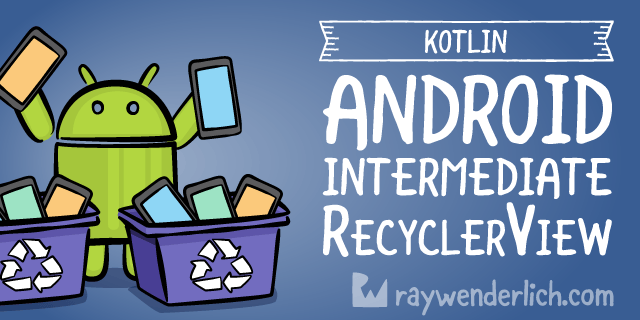
Intermediate RecyclerView Tutorial with Kotlin
Intermediate RecyclerView Tutorial with Kotlin 관련

Have you ever wanted to go to Mars or just look out over Mars’ horizon? We can’t send you there but we can give you the next best thing: an app with images from all the Mars rovers.
To show those images, we’ll use one of Android’s most popular views: the RecyclerView.
The RecyclerView layout was introduced in the Lollipop support library and Android developers have been using it for awhile. It is one of the most useful layouts and gives you more flexibility compared to a ListView in a much more performant package.
However, you may not know all that you can do with it. In this tutorial, you’ll see how to add sections, animations, dividers, and swipe gestures.
You should be familiar with the basics of using ReyclerView. If not, you can read an introduction to using RecyclerView here.
Here is a screenshot from the final version of our app:
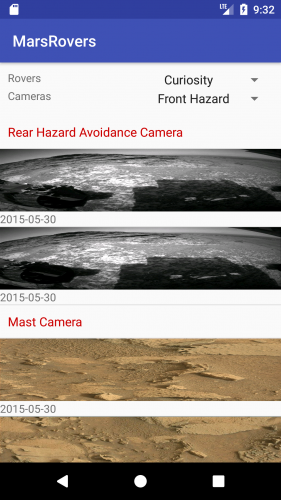
Checkout those amazing Mars landscapes!
You’re going to continue with the NASA site used in the previous RecyclerView tutorial, but do things a bit differently. You’ll be using an API that will return a list of Mars rover photos. Along with the RecyclerView of photos, there are two spinners to change the list of photos: one for rovers and the other for cameras.
Getting Started
Download the starter project here. Open it up in Android Studio 3.0.1 or later.
Next, head to the NASA site (https://api.nasa.gov/index.html#apply-for-an-api-key) and get an API key to use for the rover photos.
Build and run your app on an emulator or phone. You should see a default “Hello World!” TextView in the center.
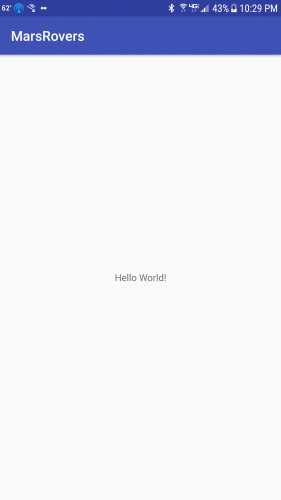
Manifest
Add the following to your AndroidManifest.xml file before the application tag:
<uses-permission android:name="android.permission.INTERNET"/>
This will allow you to get information from the NASA website. Note that this is not considered a “dangerous” permission and the user will not be asked to approve it.
String Data
To populate the spinners on the main screen, you will need to add strings for the spinners to the strings.xml file. Open strings.xml in the res/values folder and add the following after the app_name string:
<string name="api_error">Problems getting Photos</string>
<string name="rovers">Rovers</string>
<string name="cameras">Cameras</string>
<string-array name="rovers">
<item>Curiosity</item>
<item>Opportunity</item>
<item>Spirit</item>
</string-array>
<string-array name="camera_names">
<item>Front Hazard</item>
<item>Rear Hazard</item>
<item>Navigation</item>
<item>Panoramic</item>
<item>Mast</item>
</string-array>
<string-array name="camera_values">
<item>FHAZ</item>
<item>RHAZ</item>
<item>NAVCAM</item>
<item>PANCAM</item>
<item>MAST</item>
</string-array>
Main Layout
You need to modify the main layout and add some code to the MainActivity class. Start out by replacing the layout in the activity_main.xml file.
<?xml version="1.0" encoding="utf-8"?>
<android.support.constraint.ConstraintLayout xmlns:android="http://schemas.android.com/apk/res/android"
xmlns:app="http://schemas.android.com/apk/res-auto"
xmlns:tools="http://schemas.android.com/tools"
android:layout_width="match_parent"
android:layout_height="match_parent"
tools:context="com.raywenderlich.marsrovers.MainActivity">
<android.support.constraint.ConstraintLayout
android:id="@+id/control_layout"
android:layout_width="match_parent"
android:layout_height="wrap_content"
android:padding="10dp"
app:layout_constraintLeft_toLeftOf="parent"
app:layout_constraintTop_toTopOf="parent">
<TextView
android:id="@+id/roverLabel"
android:layout_width="wrap_content"
android:layout_height="wrap_content"
android:text="@string/rovers"
app:layout_constraintTop_toTopOf="parent" />
<android.support.v7.widget.AppCompatSpinner
android:id="@+id/rovers"
android:layout_width="wrap_content"
android:layout_height="wrap_content"
app:layout_constraintRight_toRightOf="parent"
app:layout_constraintTop_toTopOf="parent" />
<TextView
android:id="@+id/cameraLabel"
android:layout_width="wrap_content"
android:layout_height="wrap_content"
android:layout_marginTop="4dp"
android:text="@string/cameras"
app:layout_constraintTop_toBottomOf="@+id/roverLabel" />
<android.support.v7.widget.AppCompatSpinner
android:id="@+id/cameras"
android:layout_width="wrap_content"
android:layout_height="wrap_content"
app:layout_constraintRight_toRightOf="parent"
app:layout_constraintTop_toBottomOf="@+id/rovers" />
</android.support.constraint.ConstraintLayout>
<android.support.v7.widget.RecyclerView
android:id="@+id/recycler_view"
android:layout_width="0dp"
android:layout_height="0dp"
android:visibility="gone"
app:layout_constraintBottom_toBottomOf="parent"
app:layout_constraintLeft_toLeftOf="parent"
app:layout_constraintRight_toRightOf="parent"
app:layout_constraintTop_toBottomOf="@+id/control_layout" />
<ProgressBar
android:id="@+id/progress"
android:layout_width="wrap_content"
android:layout_height="wrap_content"
android:indeterminate="true"
app:layout_constraintBottom_toBottomOf="parent"
app:layout_constraintLeft_toLeftOf="parent"
app:layout_constraintRight_toRightOf="parent"
app:layout_constraintTop_toBottomOf="@+id/control_layout" />
</android.support.constraint.ConstraintLayout>
This uses Android's new ConstraintLayout to add two rows of spinners, one for the Rover and one for the camera. There’s a RecyclerView below the spinners. Below the RecyclerView there is a ProgressBar that will spin while the data is loading.
Now, time to modify MainActivity.kt. In the onCreate() method, after the call to setContentView, add the following:
recycler_view.visibility = View.GONE
recycler_view.layoutManager = LinearLayoutManager(this)
When Android Studio gives you an error on recycler_view, put your cursor on recycler_view and hit option+return on Mac or Alt+Enter on PC and select [Import]. This uses the Kotlin Android Extensions to turn the R.id.recycler_view id into a recycler_view variable.
Now, run the app and you should see the following:
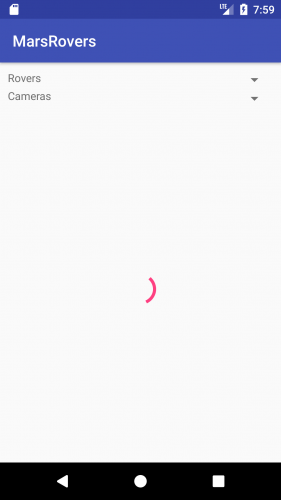
ViewHolder
The ViewHolder class holds the inflated view, is created in a RecyclerView.Adapter in onCreateViewHolder and bound in onBindViewHolder.
Before RecyclerView, Android developers used ListView to achieve similar behavior. As ListView usage matured, developers started using the “view holder” pattern and Google then made ViewHolder a key part of the RecyclerView API.
You’ll be creating a special ViewHolder class that will allow you to handle text and image views without using findViewById. In this DefaultViewHolder class, you’ll start by going through all of the child views and putting them in a map so that you can easily retrieve the view later. See the starter project for the full DefaultViewHolder class.
Adapter Layouts
You need to create the two layouts that will be used in the adapter, one for the section headers, and one for the rows themselves. First, you’ll add the header style needed for the header item layout.
Header Style
Open the styles.xml file in the values resource folder and add the following style that will be used in the header_item.xml file:
<style name="header">
<item name="android:textSize">16sp</item>
<item name="android:textColor">@android:color/holo_red_dark</item>
</style>
You can use any color you’d like. To create the header, go to the res/layout folder. Right-click and choose [New/Layout resource file]. Name the file header_item.xml. You can leave the root element as suggested and then replace everything with the following:
<?xml version="1.0" encoding="utf-8"?>
<LinearLayout xmlns:android="http://schemas.android.com/apk/res/android"
xmlns:tools="http://schemas.android.com/tools"
android:layout_width="match_parent"
android:layout_height="wrap_content"
android:orientation="vertical"
android:padding="10dp">
<TextView
android:id="@+id/header_text"
style="@style/header"
android:layout_width="match_parent"
android:layout_height="wrap_content"
tools:text="Front Hazard" />
</LinearLayout>
This is just a TextView for the header text.
Next, right-click on the layout folder and create a new layout named row_item.xml. Again, leave the root element and replace with:
<?xml version="1.0" encoding="utf-8"?>
<LinearLayout xmlns:android="http://schemas.android.com/apk/res/android"
xmlns:tools="http://schemas.android.com/tools"
android:layout_width="match_parent"
android:layout_height="wrap_content"
android:orientation="vertical">
<ImageView
android:id="@+id/camera_image"
android:layout_width="match_parent"
android:layout_height="80dp"
android:adjustViewBounds="true"
android:scaleType="fitXY" />
<TextView
android:id="@+id/date"
android:layout_width="wrap_content"
android:layout_height="wrap_content"
tools:text="10/07/2017" />
</LinearLayout>
This has an ImageView for the mars photo and a TextView for the date of the image below it.
Data
You’ll be populating the RecyclerView.Adapter using data from the NASA site: https://api.nasa.gov/api.html#MarsPhotos.
An easy way to test an API is to use the Postman Chrome extension or the Postman app https://www.getpostman.com. Once you’ve installed it, take the url https://api.nasa.gov/mars-photos/api/v1/rovers/curiosity/photos?sol=1000&api_key= and add your key to the end.
Hit the “Send” button in Postman and you’ll see the returned JSON in the Response section. Notice how it returns an object that has 1 item named photos, which is an array of objects. Now, you’ll create models to hold the data that comes back.
In Android Studio, navigate to the com.raywenderlich.marsrovers package. Right click and select [New/Package] to create a new package named models.
Next, right-click on the models package and select [New/Kotlin File/Class]. Name the file Camera, choose Class as the “Kind” and replace the generated code with the following:
data class Camera(val id: Int, val name: String, val rover_id: Int, val full_name: String)
Notice that you are using the data keyword to have Kotlin create the getters and setters for you, and that the class doesn’t need a beginning or ending brace as there are no methods. The field names match the names of the fields in the JSON response returned from the NASA API endpoint. You could make the names more readable, but you’d have to add some annotations to do that. For now, just use the given names.
Next, right-click on the models package and create a new Kotlin class named Photo and replace with the following:
data class Photo(val id : Int, val img_src : String, val earth_date: String, val camera: Camera)
Create another Kotlin class named PhotoList. The PhotoList class just holds a list of photos and is the root element of the JSON data:
data class PhotoList(val photos: List<Photo>)
Finally, create a PhotoRow class that will be used to indicate that a row is either a photo or a header. This way, you can just have a list of PhotoRow objects and check which type to show based on the value of the RowType enum. Create a new Kotlin file called PhotoRow in the models package and add the following:
enum class RowType {
PHOTO,
HEADER
}
data class PhotoRow(var type: RowType, var photo: Photo?, var header: String?)
The type property will distinguish between photos and headers. The row will have either a photo or a header string. Both the photo and header variables are nullable.
Adapter
Your adapter will extend the RecyclerView.Adapter class and use DefaultViewHolder. Navigate to the com.raywenderlich.marsrovers.recyclerview package and add a new Kotlin class called PhotoAdapter.
The class will start out like so:
class PhotoAdapter(private var photoList: ArrayList<PhotoRow>) : RecyclerView.Adapter<DefaultViewHolder>() {
Along with the passed in list of photos, create two more variables at the beginning of the class:
private var filteredPhotos = ArrayList<PhotoRow>()
private var filtering = false
The filterPhotos list is used to hold photos for a specific camera, and the filtering flag will be true when the user is filtering.
There are three abstract methods of RecyclerView.Adapter that have to be implemented: getItemCount, onCreateViewHolder, and onBindViewHolder. You will also override the getItemViewType method to return different values for the header and photo row type.
getItemCount returns the number of photos available. If filtering is on, return the size from the filtered list:
override fun getItemCount(): Int {
if (filtering) {
return filteredPhotos.size
}
return photoList.size
}
onBindViewHolder is where you load the photo or set the header text.
override fun onBindViewHolder(holder: DefaultViewHolder, position: Int) {
val photoRow : PhotoRow = if (filtering) {
filteredPhotos[position]
} else {
photoList[position]
}
if (photoRow.type == RowType.PHOTO) {
val photo = photoRow.photo
Glide.with(holder.itemView.context)
.load(photo?.img_src)
.into(holder.getImage(R.id.camera_image))
photo?.earth_date?.let { holder.setText(R.id.date, it) }
} else {
photoRow.header?.let { holder.setText(R.id.header_text, it) }
}
}
You can see that you’re using bumptech/glide to load images into the ImageView. Glide seemed to work better for all of the Mars photos than Picasso, which was only able to load some of the images.
onCreateViewHolder is where you inflate the layout and return the ViewHolder:
override fun onCreateViewHolder(parent: ViewGroup, viewType: Int): DefaultViewHolder {
val layoutInflater = LayoutInflater.from(parent.context)
val inflatedView : View = when (viewType) {
RowType.PHOTO.ordinal -> layoutInflater.inflate(R.layout.row_item, parent,false)
else -> layoutInflater.inflate(R.layout.header_item, parent,false)
}
return DefaultViewHolder(inflatedView)
}
For the two methods onCreateViewHolder and onBindViewHolder, you need to distinguish between a header and photo row. You can do that by checking the PhotoRow’s type, as you’ll see in the next section.
Section Headers
To provide headers for rows, you just need to have different row types. This is done by letting the RecyclerView know what type to use for each row.
Override the getItemViewType method and return a different integer for each type. You will be returning two different types, one for the header and one for the photo. You can use the ordinal of the enum (so the returned values will be 0 and 1). Add the following method after onCreateViewHolder.
override fun getItemViewType(position: Int) =
if (filtering) {
filteredPhotos[position].type.ordinal
} else {
photoList[position].type.ordinal
}
Both getItemCount and getItemViewType need to take into account the filtering flags to use either the original photoList or the filteredPhotos list.
In onCreateViewHolder, you load in a row_item layout for photos and a head_item layout for the header. The onBindViewHolder checks the type and binds the appropriate items to the ViewHolder.
Now run the app to make sure it builds. Since you haven’t added the adapter to the RecyclerView yet, you won’t see anything quite yet, only the spinning ProgressBar.
DiffUtil
DiffUtil is a utility class from the RecyclerView support library used to calculate the difference between two lists and create the operations that will morph one list into another. It will be used by the RecyclerView.Adapter to trigger the optimal data change notifications that are used to animate the RecyclerView‘s rows.
To use this method, you need to implement the DiffUtil.Callback. Add this to the end of the PhotoAdapter class:
class PhotoRowDiffCallback(private val newRows : List<PhotoRow>, private val oldRows : List<PhotoRow>) : DiffUtil.Callback() {
override fun areItemsTheSame(oldItemPosition: Int, newItemPosition: Int): Boolean {
val oldRow = oldRows[oldItemPosition]
val newRow = newRows[newItemPosition]
return oldRow.type == newRow.type
}
override fun getOldListSize(): Int = oldRows.size
override fun getNewListSize(): Int = newRows.size
override fun areContentsTheSame(oldItemPosition: Int, newItemPosition: Int): Boolean {
val oldRow = oldRows[oldItemPosition]
val newRow = newRows[newItemPosition]
return oldRow == newRow
}
}
This class checks the items to see if they are the same type or have the same values. The areItemsTheSame method just checks the row type but the areContentsTheSame checks to see if the rows are equal.
Additional Methods
To update the photo list, you need to pass in a new list, calculate the difference between the two lists and clear the filter. Add the following methods after getItemViewType in PhotoAdapter to support clearing the filter list, use DiffUtil to tell the Adapter how to update the photo views, and remove rows:
private fun clearFilter() {
filtering = false
filteredPhotos.clear()
}
fun updatePhotos(photos : ArrayList<PhotoRow>) {
DiffUtil.calculateDiff(PhotoRowDiffCallback(photos, photoList), false).dispatchUpdatesTo(this)
photoList = photos
clearFilter()
}
fun removeRow(row : Int) {
if (filtering) {
filteredPhotos.removeAt(row)
} else {
photoList.removeAt(row)
}
notifyItemRemoved(row)
}
Notice the notifyItemRemoved method. That method will allow animations to occur for the rows around the deleted row because it tells RecyclerView exactly how the data in the adapter has changed. It’s best not to use notifyDataSetChanged for this case, as that does not provide RecyclerView with details about exactly what has changed.
Retrofit
To get the data from NASA, you’ll be using the Retrofit and Moshi libraries. You’ll use Retrofit for downloading the data and Moshi for converting it from JSON to our models.
First, create a service interface. Create a new package named service and then right click to create a new Kotlin interface named NasaApi. Replace the code with the following:
interface NasaApi {
@GET("mars-photos/api/v1/rovers/{rover}/photos?sol=1000&api_key=<key>")
fun getPhotos(@Path("rover") rover: String) : Call<PhotoList>
}
Substitute your key from the NASA site for <key>. This sets up the method to get the list of Photos. The passed in rover string will be substitued for {rover}.
If you need to add an import for Call, be sure to use the one from the retrofit2 package.
Next, you’ll need to create the actual service. Your service should be a Singleton and in Kotlin, creating one is extremely easy.
Right click on the service package and select [New/Kotlin File/Class], name it NasaPhotos, and change the Kind to [Object]. That’s it! You now have a Kotlin Singleton.
Create a variable named service that is used in the getPhotos method:
object NasaPhotos {
private val service : NasaApi
And then add an init method. This will create the instance of Retrofit, set Moshi as the JSON converter, and finally create the service object:
init {
val retrofit = Retrofit.Builder()
.baseUrl("https://api.nasa.gov/")
.addConverterFactory(MoshiConverterFactory.create())
.build()
service = retrofit.create(NasaApi::class.java)
}
Then, create a new method to make the call for the photos:
fun getPhotos(rover: String) : Call<PhotoList> = service.getPhotos(rover)
You’re almost there. You just need to setup the spinners and the RecyclerView adapter, which you’ll do next.
Updating the main UI
It’s time to update MainActivity to setup the spinners and load some photos!
Add a few variables to hold the current rover string and the spinner positions, at the top of MainActivity
private var currentRover = "curiosity"
private var currentRoverPosition = 0
private var currentCameraPosition = 0
Above the MainActivity class declaration add:
private const val TAG = "MarsRover"
The TAG will be used for logging errors.
Add the following below the onCreate method:
private fun setupSpinners() {
setupRoverSpinner()
setupCameraSpinner()
}
private fun setupCameraSpinner() {
// Camera spinner
val cameraStrings = resources.getStringArray(R.array.camera_values)
val cameraAdapter = ArrayAdapter.createFromResource(this, R.array.camera_names, android.R.layout.simple_spinner_item)
cameraAdapter.setDropDownViewResource(android.R.layout.simple_spinner_dropdown_item)
cameras.adapter = cameraAdapter
cameras.onItemSelectedListener = object : AdapterView.OnItemSelectedListener {
override fun onNothingSelected(parent: AdapterView<*>) {
}
override fun onItemSelected(parent: AdapterView<*>, view: View, position: Int, id: Long) {
currentCameraPosition = position
}
}
}
private fun setupRoverSpinner() {
// Setup the spinners for selecting different rovers and cameras
val roverStrings = resources.getStringArray(R.array.rovers)
val adapter = ArrayAdapter.createFromResource(this, R.array.rovers, android.R.layout.simple_spinner_item)
adapter.setDropDownViewResource(android.R.layout.simple_spinner_dropdown_item)
rovers.adapter = adapter
rovers.onItemSelectedListener = object : AdapterView.OnItemSelectedListener {
override fun onNothingSelected(parent: AdapterView<*>) {
}
override fun onItemSelected(parent: AdapterView<*>, view: View, position: Int, id: Long) {
if (currentRoverPosition != position) {
currentRover = roverStrings[position].toLowerCase()
loadPhotos()
}
currentRoverPosition = position
}
}
}
These setup the spinners to hold the corresponding string arrays.
At the end of the onCreate method, add the following two lines that will setup the spinners and load the photos:
setupSpinners()
loadPhotos()
Next, you’ll load and sort our photos. Add the following after setupRoverSpinner in the MainActivity:
private fun loadPhotos() {
progress.visibility = View.VISIBLE
recycler_view.visibility = View.GONE
NasaPhotos.getPhotos(currentRover).enqueue(object : Callback<PhotoList> {
override fun onFailure(call: Call<PhotoList>?, t: Throwable?) {
Snackbar.make(recycler_view, R.string.api_error, Snackbar.LENGTH_LONG)
Log.e(TAG, "Problems getting Photos with error: $t.msg")
}
override fun onResponse(call: Call<PhotoList>?, response: Response<PhotoList>?) {
response?.let { photoResponse ->
if (photoResponse.isSuccessful) {
val body = photoResponse.body()
body?.let {
Log.d(TAG, "Received ${body.photos.size} photos")
if (recycler_view.adapter == null) {
val adapter = PhotoAdapter(sortPhotos(body))
recycler_view.adapter = adapter
} else {
(recycler_view.adapter as PhotoAdapter).updatePhotos(sortPhotos(body))
}
}
recycler_view.scrollToPosition(0)
recycler_view.visibility = View.VISIBLE
progress.visibility = View.GONE
}
}
}
})
}
fun sortPhotos(photoList: PhotoList) : ArrayList<PhotoRow> {
val map = HashMap<String, ArrayList<Photo>>()
for (photo in photoList.photos) {
var photos = map[photo.camera.full_name]
if (photos == null) {
photos = ArrayList()
map[photo.camera.full_name] = photos
}
photos.add(photo)
}
val newPhotos = ArrayList<PhotoRow>()
for ((key, value) in map) {
newPhotos.add(PhotoRow(RowType.HEADER, null, key))
value.mapTo(newPhotos) { PhotoRow(RowType.PHOTO, it, null) }
}
return newPhotos
}
You’ll have to import a few classes to get rid of the errors. Note that any of the imports that provide multiple options should use the ones in the retrofit2 package.
In the sortPhotos method, you put the photos into sections arranged by camera.
Now it’s time to try it out. Build and run the app, and within about 10 or 20 seconds, you should see something like:

If you don’t see any images, make sure you have your personal key in the Retrofit @GET annotation.
You can choose different rovers from the spinner in the top right and different cameras from the spinner below the rover spinner but they won’t do anything until they are hooked up. Note also that not all rovers have images from all cameras.
Filtering
In order to filter the list, add the filterCamera method to PhotoAdapter below getItemViewType:
fun filterCamera(camera: String) {
filtering = true
val newPhotos = photoList.filter { photo -> photo.type == RowType.PHOTO && photo.photo?.camera?.name.equals(camera) } as ArrayList<PhotoRow>
DiffUtil.calculateDiff(PhotoRowDiffCallback(newPhotos, photoList), false).dispatchUpdatesTo(this)
filteredPhotos = newPhotos
}
Now go back to your MainActivity and hook up the camera filtering. Add the following code to the beginning of the OnItemSelectedListener.onItemSelected() in the setupCameraSpinner method:
if (recycler_view.adapter != null && currentCameraPosition != position) {
(recycler_view.adapter as PhotoAdapter).filterCamera(cameraStrings[position])
}
You pass in the camera string to filter on and create a new list with just those photos. You use Kotlin’s filter function on the collection and return a list of photos and has the given camera value.
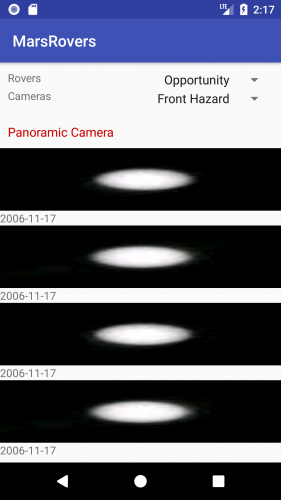
ItemDecorators
Unlike ListView, RecyclerView does not come with any built-in dividers. Instead, RecyclerView allows you to add your own decorators.
The RecyclerView library comes with a DividerItemDecoration that can be used to put dividers between your rows. You can add a divider with this one line, which you should add to onCreate() in MainActivity after the line: recycler_view.visibility = View.GONE:
recycler_view.addItemDecoration(DividerItemDecoration(this, DividerItemDecoration.VERTICAL))
You can see the divider after the photo date on the last photo in a section.
To create your own decorator, just subclass ItemDecoration and implement the onDraw and/or the onDrawOver methods.
Animations
__RecyclerView__s allow animations for each row and provides built-in animations for adding and removing rows.
To show an animation for adding a row, make sure you use notifyItemAdded(position) instead of calling notifyDataChanged(). This lets the view know that just one row has been added and can animate that addition.
For deleting, call notifyItemRemoved(position).
To animate the addition of each item, add the following method to PhotoAdapter:
private fun setAnimation(viewToAnimate: View) {
if (viewToAnimate.animation == null) {
val animation = AnimationUtils.loadAnimation(viewToAnimate.context, android.R.anim.slide_in_left)
viewToAnimate.animation = animation
}
}
This will provide an animation where the row slides in from the left.
Then add:
setAnimation(holder.itemView)
as the last line in onBindViewHolder. Now try running again.
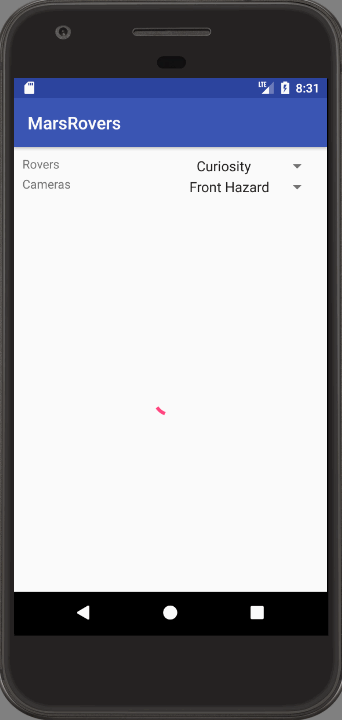
Swiping
Swiping is great way to let your user delete rows. You’re going to implement swiping in both the left and right direction to delete a row.
RecyclerView uses an ItemTouchHelper class along with a swipe callback to handle the movement. The callback is simple and you will just call your adapter’s removeRow method in the onSwiped callback.
Open MainActivity.kt and add the following at the bottom of the class:
class SwipeHandler(val adapter: PhotoAdapter, dragDirs : Int, swipeDirs : Int) : ItemTouchHelper.SimpleCallback(dragDirs, swipeDirs) {
override fun onMove(recyclerView: RecyclerView?, viewHolder: RecyclerView.ViewHolder?, target: RecyclerView.ViewHolder?): Boolean {
return false
}
override fun onSwiped(viewHolder: RecyclerView.ViewHolder, direction: Int) {
adapter.removeRow(viewHolder.adapterPosition)
}
}
In loadPhotos you will find the following in the onResponse method:
if (recycler_view.adapter == null) {
val adapter = PhotoAdapter(sortPhotos(body))
recycler_view.adapter = adapter
Add the following after setting the adapter value:
val touchHandler = ItemTouchHelper(SwipeHandler(adapter, 0, (ItemTouchHelper.LEFT or ItemTouchHelper.RIGHT)))
touchHandler.attachToRecyclerView(recycler_view)
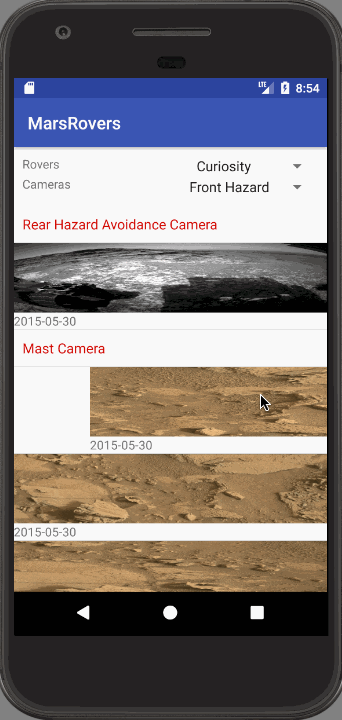
Awesome! You’re just deleting the row from the display in the RecyclerView. In another app you would likely delete the item from a database and/or make an API call to delete the corresponding item on a server.
Where to go from here
You’ve done a lot of work and now you know how to add animations, provide a swipe handler, add section headers, and use the DiffUtil class. Well done!
A great next step would be to eliminate the PhotoRow model class and DefaultViewHolder and get the project working with separate Header and Photo model objects and a dedicated ViewHolder for each.
The final project for this tutorial is available here. In the final project, be sure to remember to set the API key in NasaApi.kt.
If you need more information on RecyclerViews, you can check out the following Android developer documentation:
I hope you enjoyed this Intermediate RecyclerView tutorial, and if you have any questions or comments, please join the forum discussion below!
Go forward and make great animated RecyclerViews!